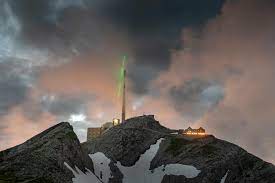For the first time, scientists utilize a laser to steer a lightning bolt
Worldwide, lightning strikes 40–120 times per second, killing more than 4,000 people each year and incurring billions of dollars in damage.
Yet the lightning rod, which was invented by American polymath Benjamin Franklin in 1749, continues to be the primary defense against these aerial bolts.
Since years, a group of scientists from six research institutes has been attempting to use the same concept but utilize a much more complex and precise laser in place of the simple metal pole.
Now, they explain utilizing a laser beam—shot from the peak of a Swiss mountain—to guide a lightning bolt for more than 50 meters in a study that was just published in the journal Nature Photonics.
Aurelien Houard, a physicist at the ENSTA Paris institute’s applied optics department and the study’s principal author, stated, “We wanted to deliver the first demonstration that the laser may have an affect on lightning — and it is simplest to guide it.
However, Houard told AFP that “it would be much better if we could trigger lightning” for upcoming applications.
How to catch lightning
Lightning is a discharge of static electricity that has built up in storm clouds, or between clouds and the ground.
The laser beam creates plasma, in which charged ions and electrons heat the air.

According to Houard, that laser failed because it did not produce enough pulses per second to ignite lightning, which does so in milliseconds.
It was also challenging to “predict where the lightning was going to fall,” he continued. The scientists didn’t take many chances with their most recent experiment.
They carried a car-sized laser up the 2,500-meter peak of the Santis mountain in northern Switzerland. This laser can fire up to a thousand pulses of light per second. A communications tower on the top experiences lightning strikes about 100 times annually.
The strong laser took two years to construct, and many weeks to transport it via cable car in sections. The enormous containers that would hold the telescope had to be dropped off by helicopter at the end.
The telescope concentrated the laser beam at a point approximately 150 meters in the air — just above the top of the 124-meter tower — where it was at its strongest. The beam is 20 centimeters in diameter at the bottom and only a few centimeters in diameter at the top. Jump on the lightning
The beam has a diameter of 20 centimetres at the beginning, but narrows to just a few centimetres at the top.
Ride the lightning
During a storm in the summer of 2021, the scientists were able to photograph their beam driving a lightning bolt for 50 around metres.
Three other strikes were also guided, interferometric measurements showed.

The majority of lightning develops from precursors inside the clouds, however if the electric field is strong enough, some lightning may also rise from the ground.
“Once the ground is connected to the cloud, the current and strength of a lightning bolt really become obvious,” Houard added. One of these predecessors is guided by the laser, making it “far quicker than the others — and straighter,” the scientist claimed.
Then, before it lights up, it will be the first to connect with the cloud. This indicates that, theoretically, this method may be used to both provoke lightning and drive it away.
That would necessitate a high plasma conductivity in the laser, which experts do not believe they have yet accomplished.
AFP



